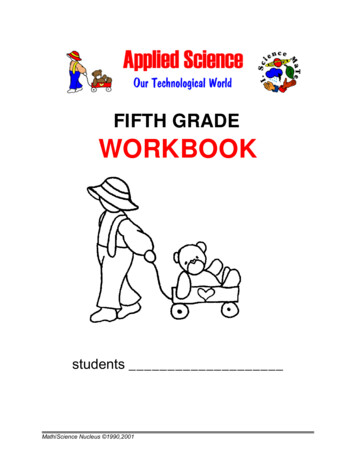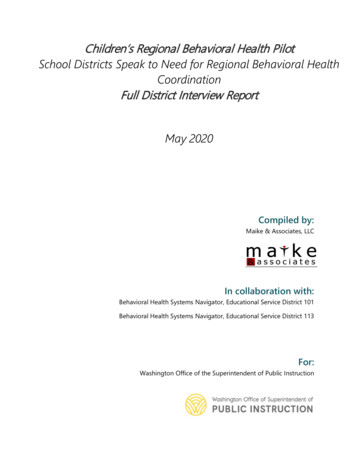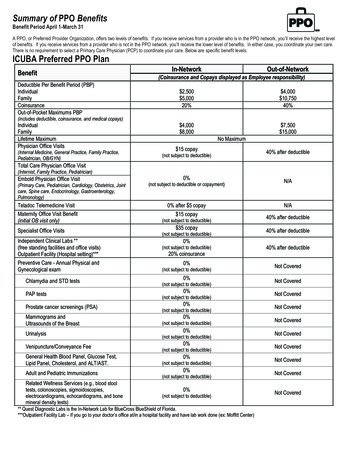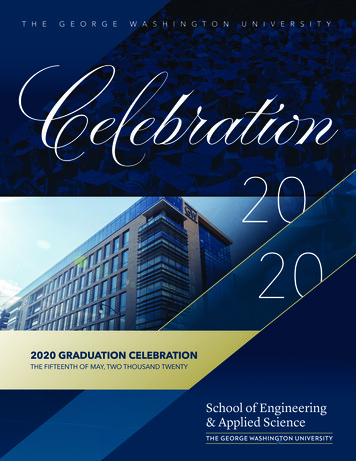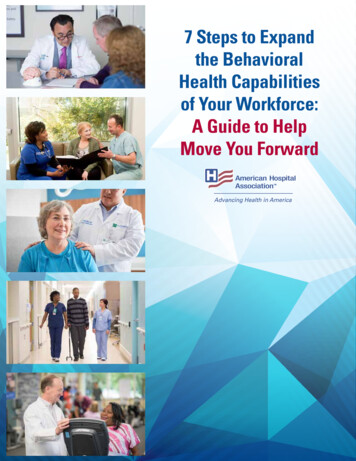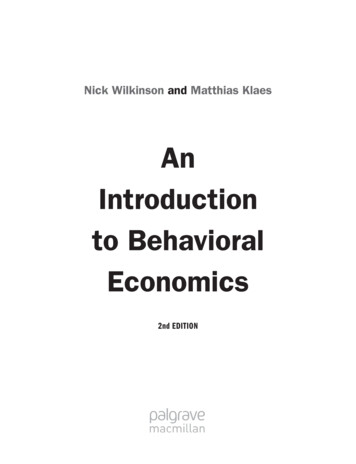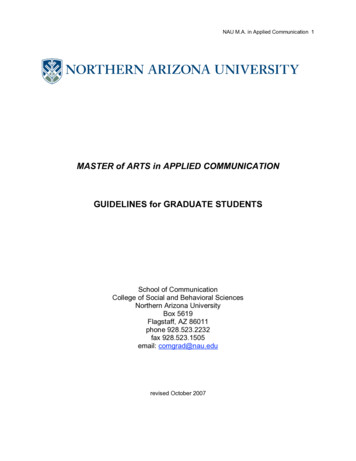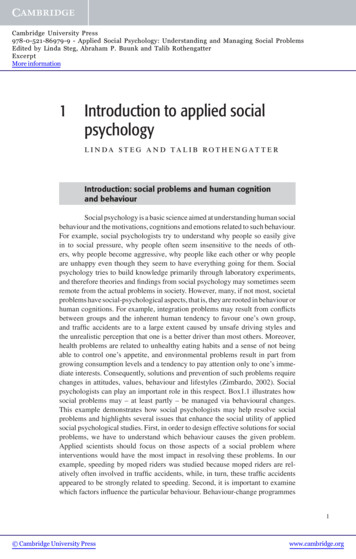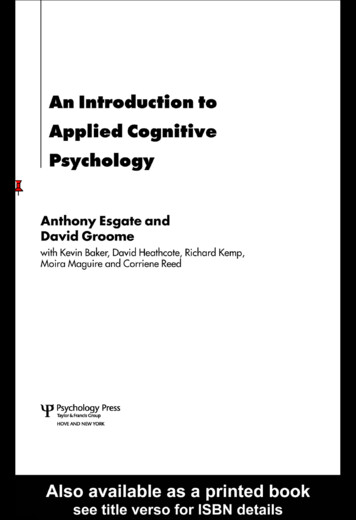
Transcription
Introduction toAppliedBehavioral ScienceEda CetinokNamika SagaraApril 27, 2017 2017 Ipsos1
Your Presenters TodayEda CetinokSenior Vice President, Ipsos Loyalty US 2017 IpsosNamika SagaraPresident, Ipsos Behavioral Science CenterNorth m 1 317.805.4873 1 646.313.77122
Why Behavioral Science?C-Suite ranks customer insights as theirtop priorityVISION 2017 IpsosNounderstandingCurrentunderstandingYet made little progresswith the value they are gettingwith BSciConsumer BehaviorCompleteunderstanding3
INTRO TO BEHAVIORAL SCIENCEWHERE ARE WE TODAY? What is Behavioral Science? Thinking fast, thinking slow: 2 systems How BSci help your Market Research? 2017 Ipsos4
What is Behavioral Science?Behavioral Science is an interdisciplinary field of science (e.g., social and cognitive psychology,judgment and decision making, and behavioral decision theory) which generates and appliesinsights to understand, predict, and ultimately implement behavioral change.“Chief Behavioral Officer: It's the new ‘must-have’ role.” 2017 Ipsos Crawford Hollingworth5
What is Behavioral Science?Traditional Economics Rational Resources available and we usethem to make the best and mostinformed decisions Know what’s best Predictive models based onmathematicsIf we all behaved like “Econ”: We’d spend significant amount of time carefullyweighing the product, service and price attributesof all options to make optimal purchase decisionsevery time in every category We’d choose breakfast based on fiber and othernutrition contents. We’d never have any problem of over-eating orunder-exercising. 2017 Ipsos We’d never have problems to plan for future, e.g.,saving for retirement, research and purchase righttypes of insurance.6
What is Behavioral Science?Traditional Economics Rational Resources available and used tomake the best and informeddecisions Know what’s best Predictive models based onmathematics.Behavioral Economics Irrational Bounded resources andwillpower Heuristics Don’t Know What’s Best Or WhatWe Want Interested In How? & Why? Conduct Experiments To LearnAbout Human BehaviorsHow we should behave 2017 IpsosHow we actually behaveAt Least Sometimes 7
BEHAVIORAL ECONOMICS IN CONSUMER BEHAVIOR“Irrational” Behavior 2017 Ipsos8
BEHAVIORAL ECONOMICS IN CONSUMER BEHAVIORSystem 2 Way of Nudging 2017 Ipsos9
BEHAVIORAL ECONOMICS IN CONSUMER BEHAVIORSystem 1 Way of Nudging 2017 Ipsos10
Are We Rational? Are people rational? Do our research methodologies assume that people are rational? Do we analyze our research based on the assumption that they are rational? 2017 Ipsos11
INTRO TO BEHAVIORAL SCIENCEWHERE ARE WE TODAY? What is Behavioral Science? Thinking fast, thinking slow: 2 systems How BSci help your Market Research? 2017 Ipsos12
Two-System Models of Cognition Soul vs. Mind (Aristotle) Id vs. Ego (Freud) Lizard brain vs. Monkey brain (pop psychology) Heart vs. Mind (Your mom, offering advice) Tacit vs. Deliberate (Hogarth 2001) Experiential vs. Rational (Epstein 1994) Associative vs. Rule Based (Sloman 1996) System 1 vs. System 2 (Stanovich & West 2002) 2017 Ipsos
Fast vs. Slow ProcessFast Process UnconsciousNon-logicalAutomaticLow EffortHigh capacityHard to articulateSlow Process ConsciousLogicalControlledHigh effortSmall capacityLinked languageProvides reasonsWe can never turn off our fast process. 2017 Ipsos14
CASE STUDYHow to make a loyalty program more effective?Endowed progress effect increases sales by 79% 2017 Ipsos15
INTRO TO BEHAVIORAL SCIENCEWHERE ARE WE TODAY? What is Behavioral Science? Thinking fast, thinking slow: 2 systems How BSci help your Market Research? 2017 Ipsos16
How we can use Behavioral Science in improving Market Research?COLLECTHow can we get lessbiased data/moreaccurate responses?Behavioral Science can help Ask even better questions How to frame questions What choice options topresent Avoid our own and clientbiases 2017 IpsosANALYSE & INTERPRETWhat does your datamean? Behavioral Science offersinsights on how peoplethink and behave, whichhelp us to think about howto approach the data andhow to get stories out ofthe data.IMPACT CX STRATEGYHow do we applyresearch insights todeveloping andactioning strategy? We can put BehavioralScience to work to deliveradded valuerecommendations to increating customerexperience strategies totactics to marketingcommunications.17
How does Ipsos integrate BSci in research design & delivery?Some examples:COLLECT Design short surveys thatallow respondents to mimictheir fast decision makingprocesses, which useHeuristics 2017 IpsosANALYZE & INTERPRET Reflect ReferencePoints argument bycreating competitivecontext throughrelative scales, etc.IMPACT CX STRATEGY Leverage ChangeManagementConsulting tools andBSci concepts like PeakEnd Rule to help clientsformulate action plansto activate researchfindings18
TOP BSCI EFFECTS 2017 Ipsos19
Many Behavioral Science Principles Countless Opportunities for Application 2017 Ipsos20
OVERVIEW: TOP BEHAVIORAL SCIENCE EFFECTS“FLATS”FRAMINGLOSS AVERSIONANCHORINGTIMESALIENCE 2017 Ipsos21
OVERVIEW: TOP BEHAVIORAL SCIENCE EFFECTSEach “FLATS” category includes several of those “BSci ionBiasLOSS AVERSIONLossAversionStatus QuoEndowment& AnchoringReferencePointBase RateFallacyPresentMattersPeak TIME 2017 IpsosSALIENCE22
COLLECT Example: Using Framing to Ask Better QuestionsNudge people towards responding honestly ona topic that carries a social-stigma for manyFramingAdjusted ScalingPrimingFraming questions through thelens of acceptance can alleviatethe fear of admitting to asocially-taboo behavior.Utilizing larger and moresubjective scales can promote asense of normalcy, even forheavier users.Priming consumers with a “warmup” exercise that implicitly promoteshonesty has been show to actuallyelicit more honest responses.Negative Example:Are you a smoker? Do you smoke?Could elicit defensiveness or fear ofbeing labeled.Negative Example:How often do you smoke? “Veryoften, Somewhat often, etc.”Conveys that smoking “very often”is an extreme behavior.Negative Example:No warm-up. Requires them toimmediately open-up on a topic that mayfeel too personal.Positive Example:When was the last time yousmoked? Shifts the focus tofrequency instead of admitting to a behavior.2017 IpsosPositive Example:How many times did you smoke lastweek? Assumes smoking last weekwas okay.Positive Example:Conduct a word association exercise on anunrelated topic using words like “honest”,“pure”. Encourages an open mindset.23
COLLECT Example: Using BSci to Tweaks Invites to Secure Better Response RatesIncrease customers’ likelihood to respond toresearch by providing the right motivationFeedback, Reminders,Self-MonitoringLoss AversionReciprocityWe feel disproportionate painover losses and tend to takegains for granted. This leads usto strongly prefer avoidinglosses, rather than acquiringgains.Reciprocity involve “in-kind”exchanges between people;responding to another’s actionwith equivalent action.Feedback and reminders (in-person,in a diary, using a phone call or viaSMS) on progress toward achieving abehavioral goal can have significanteffects.The invite reads” You have beencarefully chosen to participate in aproject where your junk mail worksfor you”We included study directions on acalendar and added the followingprompt: “ You don’t need to doanything extra! Just keep the enclosedenvelopes in convenient locations asyou sort through your mail.”Gain Example:Turn Clutter into CashLoss Example:Every time you throw away yourmail, you could be throwing awaydollars!Taps into consumers’ fear of losing 2017 IpsosMaking people think we wentthrough the effort to select themmakes them more likely to feelcompelled to participate.Including memory cues helps boostcompliance.24
McKinsey Example: Various BSci Principles Applied to CX Design25 2017 IpsosPutting Behavioral Psychology to Work to Improve the Customer Experience, Dilip Bhattacharjee, Keith Gilson, and Hyo Yeon, McKinsey & Co, March 2016
TIME 2017 Ipsos26
WE REMEMBER AND JUDGE EXPERIENCES BY IT’S PEAKS AND ENDSExperiencing vs. RememberingEXPERIENCING SELFREMEMBERING SELFhttps://www.ted.com/talks/daniel kahneman the riddle of experience vs memory 2017 Ipsos27
WE REMEMBER AND JUDGE EXPERIENCES BY IT’S PEAKS AND ENDSImplications for Decision MakingREMEMBERING SELFEXPERIENCING SELFhttps://www.ted.com/talks/daniel kahneman the riddle of experience vs memory 2017 Ipsos28
WE REMEMBER AND JUDGE EXPERIENCES BY IT’S PEAKS AND ENDSPeak-End 2017 Ipsos29
PEAK-END: IMPLICATIONS FOR CUSTOMER EXPERIENCE DESIGNImproving CX in the Hospitality Industry 2017 Ipsos30
PEAK-END: IMPLICATIONS FOR CUSTOMER EXPERIENCE DESIGNImproving CX with Call Centers 2017 Ipsos31
LOSS AVERSION 2017 Ipsos32
Loss Aversion 2017 Ipsos33
LOSS AVERSIONInsurance Imagine that you are looking for insurance for a new car you’ve just purchased.Suppose you are offered the policy described below Group 1: Deductible FrameGroup 2: Rebate FrameAnnual premium: 1,000Deductible: 600Annual premium: 1,600Rebate: 600A rebate of 600 minus any claims paid will begiven to you at the end of the year.YES44% 2017 IpsosYES68%34
Endowment and Virtual Ownership 2017 Ipsos35
Endowment and Virtual Ownership 2017 Ipsos36
Scarcity 2017 Ipsos37
Scarcity 2017 Ipsos38
How can Ipsos help you?Partnership with: 2017 IpsosS SystematicM MultifacetedA ActionableR RigorousT Timely1BSci InfusedMR Projects2Custom BSciExperiments34BSci AuditsBSciWorkshops39
2017 Ipsos40
2017 Ipsos41
Apr 27, 2017 · Fast vs. Slow Process Conscious Logical Controlled High effort Small capacity Linked language Provides reasons. Fast Process. Slow Process . think and behave, which help us to think about how to approach the data and how to get s


